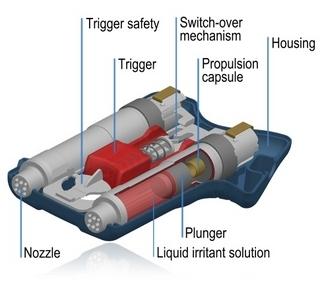Table of Contents
- Understanding the Chemical Composition and Mechanism of Pepper Spray
- The Physiological Effects on the Human Body Explained
- Best Practices for Safe and Effective Use in Self-Defense
- Legal Considerations and Responsible Handling Recommendations
- Insights and Conclusions
Understanding the Chemical Composition and Mechanism of Pepper Spray
Pepper spray is primarily composed of oleoresin capsicum (OC), a natural oily extract derived from the fruit of the Capsicum species-commonly known as hot peppers. This extract contains capsaicin, the active ingredient responsible for the intense burning sensation. Typically, the concentration of capsaicin in pepper spray varies between 2% to 10%, with higher concentrations delivering more powerful effects. The OC is suspended in a liquid carrier, often combined with propellants such as nitrogen or carbon dioxide to ensure effective aerosolized deployment. Additional inert ingredients stabilize the formulation and optimize spray pattern and range.
Upon deployment, the spray causes an immediate inflammatory response on mucous membranes and soft tissues, targeting the eyes, nose, throat, and skin. This reaction includes:
- Intense burning and irritation that temporarily blinds and incapacitates the attacker
- Swelling of the conjunctiva in the eyes, causing involuntary eyelid closure
- Coughing and difficulty breathing triggered by inflammation of the respiratory tract
This multifaceted mechanism effectively disables aggressive individuals without causing permanent damage, making pepper spray a preferred non-lethal self-defense tool in law enforcement and civilian use alike.
The Physiological Effects on the Human Body Explained
Pepper spray exerts its impact primarily through the activation of nociceptors, the sensory neurons responsible for detecting pain and irritants. Once sprayed, the active compound-capsaicin-binds to receptors in the mucous membranes of the eyes, nose, throat, and skin. This binding triggers an intense burning sensation and inflammation, leading to a series of involuntary physiological responses designed to protect the body. For instance, the eyes respond with excessive tearing and involuntary closure, effectively impairing vision. Simultaneously, the respiratory tract experiences inflammation and constriction, causing coughing, choking, and difficulty breathing – all of which significantly hinder an assailant’s ability to continue hostile actions.
- Ocular irritation: Severe eye pain, redness, and temporary blindness caused by conjunctival irritation
- Respiratory distress: Increased mucus production, bronchial constriction, and coughing spasms
- Skin reaction: Burning, redness, and localized swelling where the spray contacts skin
- Neurological response: Rapid activation of pain pathways leading to disorientation and difficulty focusing
These physiological changes work synergistically, exploiting the body’s own defense systems to incapacitate without causing permanent harm. The intense pain and sensory overload overwhelm the nervous system, making it difficult to maintain physical control or continue aggressive behavior. Understanding these effects not only sheds light on why pepper spray is effective but also emphasizes the importance of proper handling and respect for its potent biological impact.
Best Practices for Safe and Effective Use in Self-Defense
When deploying pepper spray for self-defense, it is crucial to remain calm and focused under pressure. Always aim for the attacker’s face, specifically the eyes, to maximize the spray’s effectiveness. Remember, a short burst-usually 1 to 3 seconds-is sufficient to incapacitate without wasting the canister’s contents. Practicing with an inert training spray can help you gain confidence in your aim and deployment speed, which could be vital in a real-life scenario. Additionally, be aware of wind conditions; avoid spraying in windy environments that could blow the irritant back toward you.
After using pepper spray, immediately create distance and seek a safe location to escape the threat. Never attempt to re-engage the attacker or remain in close proximity, as the spray only provides temporary distraction and incapacitation. It’s also important to remember that pepper spray is a non-lethal deterrent, so always carry it as part of a broader personal safety plan that includes awareness, avoidance, and other defense strategies. Keep the canister readily accessible but locked away from children or unauthorized users for safety and legal compliance. Regularly check expiration dates and ensure the spray is functioning properly to maintain reliability during emergencies.
Legal Considerations and Responsible Handling Recommendations
Before acquiring or using pepper spray, it’s crucial to understand the legal framework governing its possession and deployment. Laws vary widely by jurisdiction, with some areas requiring permits, restricting concentration levels, or banning it outright. Carrying pepper spray in prohibited regions can lead to significant legal consequences, including fines or arrest. Ensure that you research local regulations thoroughly and comply with any registration or licensing requirements to avoid inadvertent violations.
When handling pepper spray, responsible usage is essential to maximize safety and effectiveness. Always store the canister in an accessible yet secure location to prevent accidental discharge or misuse. Avoid spraying in enclosed spaces or towards the wind to minimize self-exposure. Regularly check the expiration date and perform a controlled test spray to maintain functionality without wasting the product. Practicing proper aim, aiming for the assailant’s face specifically the eyes, can incapacitate threats quickly while reducing collateral irritation. Adhering to these guidelines fosters respectful self-defense and ethical protection.
- Confirm local legality and restrictions before possession
- Store securely away from children and unauthorized users
- Use only in genuine self-defense situations to avoid legal issues
- Conduct periodic inspections for expiration and functional reliability
- Practice proper deployment technique for safe and effective use
Insights and Conclusions
In summary, understanding how pepper spray works provides valuable insight into its effectiveness as a self-defense tool. By targeting the body’s pain receptors and causing intense irritation, pepper spray offers a non-lethal means to incapacitate potential threats swiftly and safely. Whether you’re considering it for personal protection or simply expanding your knowledge, appreciating the science behind pepper spray empowers you to use it responsibly and confidently. Stay informed, stay safe, and always prioritize awareness in any situation.Check Our Other Blogs
- StunGun – Your Trusted Source for Stun Guns, Laws, and Self-Defense Tips
- PepperSprayLaws – Your Trusted Resource for Pepper Spray Information
- StunGunLaws – Your Trusted Guide to Stun Gun Legality and Safety




